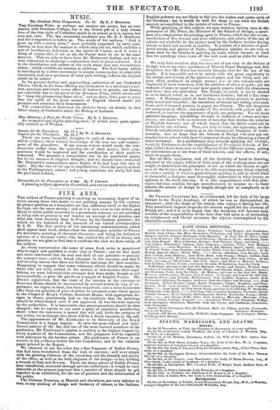FINE ARTS.
THE subject of Fresco-painting is exciting an increasing degree of in- terest among those who desire to see painting assume in this country its proper position as a decorative art that addresses itself to the higher feelings, not the sense merely ; and as it is new even to our artists, and likely to claim public attention in a prominent manner, we are gratified at being able to present to our readers an account of the process, and what has been recently done in Fresco by the German painters ; for which we are indebted to the research of our valued correspondent R. S. H. The first portion of his interesting communication, which shall appear next week, makes clear the advantages peculiar to Fresco for decorative painting of elevated character ; and being the deliberate opinion of a German writer who has studied the art in its theory and practice, we are glad to find that it confirms the view we have taken of the subject.
At every conversation the name of some fresh artist is mentioned who-is eager and qualified to make trial of Fresco ; and we feel more and more convinced that the zeal and skill of our painters—e.pecially the younger ones—will be found adequate to the occasion, and that it will develop talents that have not hitherto had scope for their exercise. Happening to suggest that some voluntary efforts should be made, by those who are most earnest in the matter, to demonstrate their capa- bilities, we were informed that attempts had been made, though as yet unsuccessfully, to give the public an example of English Fresco. Mr. DYCE'S suggestion, that the roofs of the arcades at the entrance to Somerset House should be ornamented by several artists by way of ex- periment, we regret to hear, has been negatived ; and a most handsome offer from six painters of proved ability to ornament some blank spaces in the Chapel of King's College, Somerset House, with appropriate de- signs in fresco, gratuitously, and on the condition that the paintings should be whitewashed over if not approved of, was likewise rejected by the authorities. It is lamentable that generous ardour should be thus damped ; but we rejoice to see such a spirit of emulation manifesting itself: when the summons is issued that will call forth the energies of our artists, we anticipate that there will be a lively response to the call. The appointment of Mr. EASTLAKE to be Secretary of the Royal Commission is a happy augury. At once the most refined and intel- lectual painter of the day and one of the most learned members of the profession, Mr. EASTLAKE'S opinion is entitled to the highest respect by every member of the Commission, and his judgment will be regarded with deference by his brother artists. His preference of Fresco is on record, in his evidence before the late Committee, and in the valuable paper printed in the Report.
We chanced to see the other day a fine fragment of Italian Fresco, that bad been transferred from the wall to canvass ; and were struck with the glowing richness of the colouring and the breadth and purity of the effect, as well as the bold elegance of the design—a boy holding a wreath of fruit and flowers. There are many pieces of Italian Fresco, thus transferred, scattered through private collections: it would be very desirable at the present juncture that a number of these should be got together in an exhibition, for the use of painters and the information of the public.
The German Frescoes, at Munich and elsewhere, are very inferior in tone, to say nothing of design and harmony of colour, to the Italians. English painters are not likely to fall into the leaden and opake style of the Germans ; but it would be well for them to see what the Italian masters accomplished in the article of colour in Fresco.
While gossiping on this subject, we may mention having seen in the possession of Mr. DYCE, the Director of the School of Design, a speci- men of a composition for painting upon in Fresco, which has the recom- mendations of fine texture and pure whiteness, and admits of the use of colours not available in the plaster used by the Italians, besides drying almost as hard and smooth as marble. It consists of a mixture of pow- dered marble and plaster of Paris ; ingredients similar, we are told, to those used by the Greeks in painting on walls, which became so hard that the paintings when sawn off the wall were used as slabs for tables.


























 Previous page
Previous page